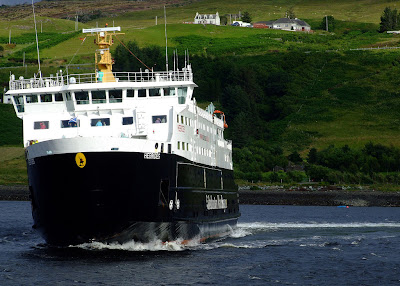Looking like a cross between a prison camp and a work house, if this was in the Channel Islands, you could imagine they held some dark secret of the Nazi occupation but this is, in fact, Hynish, the shore base for the construction of the Skerryvore Lighthouse.
Built between 1838 and 1844 under the supervision of engineer Alan Stevenson (uncle of the author of Treasure Island, Robert Louis Stevenson), Skerryvore is built of granite quarried on Mull which was brought to Hynish to be shaped into blocks before being shipped out to the reef 10 miles (16km) south west of Tiree and incorporated into the rising structure of the lighthouse.
 |
| Hynish and Skerryvore on the Scotland - West Coast admiralty chart |
 |
| Skerryvore Lighthouse - photo credit Ian Cowe |
I first learnt about Hynish in 1994 when I visited Tiree on holiday. The signal tower which communicated by semaphore with the workers on the rock is a museum about the construction of the lighthouse while the keepers' houses are now affordable homes for Tiree residents. The remainder of the buildings form the Hynish Centre run by the Hebridean Trust for holding conferences and courses etc.
 |
| Hynish Wet Dock - picture credit Clyde Cruising Club |
 |
| Hynish by Niall Corbet |
Even more interesting is that the wet dock at Hynish didn't rely on a high tide to be filled up but was equipped with an onshore reservoir of fresh water to fill it. You can see the whole arrangement clearly on the OS 25 inch map of 1878 when the wet dock was apparently still in operation:-
What always strikes me about these things is that Victorian engineers like Stevenson - with no GPS or internet or software and presumably just pencil and paper - had to think about stuff like the shore base as well as the lighthouse on the rock. The wet dock would have been quite an achievement on its own!
The reservoir with its associated dam and sluice are also still clearly visible on Google Earth:-
You can see them quite clearly on the ground as well:-
The point of this post is I think it's fascinating to discover examples of such quintessential Victorian engineering as a wet dock (albeit on a small scale) in such a remote location as Tiree. And in such a state of preservation. Also, how it's possible to go for a virtual look round the past and the present without leaving my seat here in the Azores courtesy of such resources as Google Earth and National Libraries of Scotland Maps. But if you are actually going to Tiree any time soon, do go up on that dam and take a few photos and add them to Canmore.
 |
| Extract from OS 1 inch sheet 44 Coll & Tiree |


















